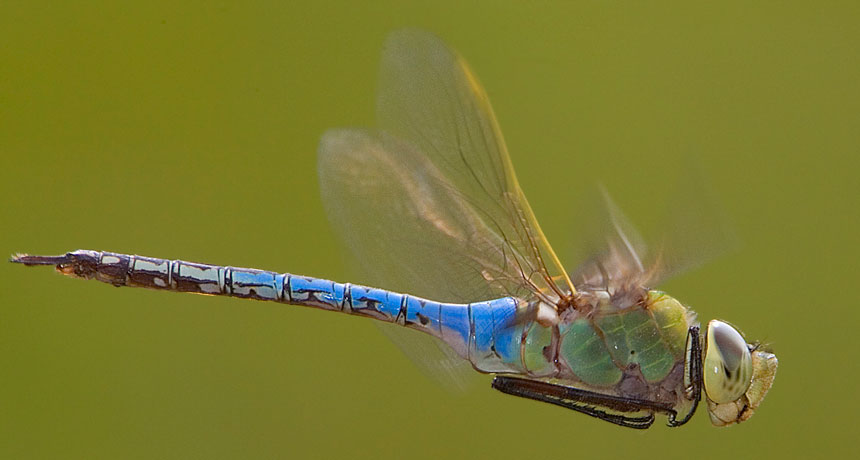Green darner dragonflies migrate a bit like monarch butterflies
Each annual migratory loop takes multiple generations

TOWARD THE UNKNOWN A common green darner can migrate hundreds of kilometers each year. A new study reveals details of the insects’ annual migration for the first time.
Mark Chappell
The monarch butterfly isn’t the only insect flying up and down North America in a mind-boggling annual migration. Tests show a big, shimmering dragonfly takes at least three generations to make one year’s migratory loop.
Ecologist Michael Hallworth and his colleagues pieced together the migration of the common green darner, described December 19 in Biology Letters, using data on forms of hydrogen in the insects’ wings, plus records of first arrivals spotted by citizen scientists.
The study reveals that a first generation of insects emerges in the southern United States, Mexico and the Caribbean from about February to May and migrates north. Some of those Anax junius reach New England and the upper Midwest as early as March, says Hallworth, of the Smithsonian Migratory Bird Center headquartered in Washington, D.C.
Those spring migrant darners lay eggs in ponds and other quiet waters in the north and eventually die in the region. This new generation migrates south from about July until late October, though they have never seen where they’re heading. Some of these darners fly south in the same year their parents arrived and some the next year, after overwintering as nymphs.
A third generation emerges around November and lives entirely in the south during winter. It’s their offspring that start the cycle again by swarming northward as temperatures warm in the spring. With a wingspan as wide as a hand, they devote their whole lives to flying hundreds of kilometers to repeat a journey their great-grandparents made.
Mass migration
At least three generations make up the annual migration of common green darner dragonflies. The first generation emerges in the southern United States, Mexico and the Caribbean starting around February and flies north. There, those insects lay eggs and die, giving rise to second generation that migrates south until late October. (Some in that second generation don’t fly south until the next year, after overwintering as nymphs.) A third generation, hatched in the south, overwinters there before laying eggs that will start the entire process over again. These maps show the emergence origins of adult insects (gray is zero; red is many) captured at sampling locations (black dots).

Scientists knew that these dragonflies migrated. Dragonfly enthusiasts have spotted swarms of the green darners in spring and in fall. But which generations were doing what has been tricky to demonstrate. “Going in, we didn’t know what to expect,” Hallworth says.
Tracking devices that let researchers record animals’ movements for more than a week or two haven’t been miniaturized enough to help. The smallest still weigh about 0.3 grams, which would just about double a darner’s weight, Hallworth says. So researchers turned to chemical clues in darner tissues. Conservation biologist and study coauthor Kent McFarland succeeded at the delicate diplomacy of persuading museums to break off a pinhead-sized wing tip fragment from specimens spanning 140 years.
Researchers checked 800 museum and live-caught specimens for the proportion of a rare heavy form of hydrogen that occurs naturally. Dragonfly wings pick up their particular mix of hydrogen forms from the water where the aquatic youngsters grow up. Scientists have noticed that a form called hydrogen-2 grows rarer along a gradient from south to north in North America. Looking at a particular wing in the analysis, “I can’t give you a zip code” for a darner, Hallworth says. But he can tell the native southerners from Yankees.
An adult darner, regardless of where it was born, is “a green piece of lightning,” says McFarland, of the Vermont Center for Ecostudies in White River Junction. Darners maneuver fast enough to snap insect prey out of the air around ponds across North America. The front of an adult’s large head is “all eye,” he says, and trying to catch samples for the study was “like hitting a knuckleball.”
Although the darners’ north-south migration story is similar to that of monarchs (Danaus plexippus), there are differences, says evolutionary biologist Hugh Dingle of the University of California, Davis, who has long studied these butterflies. Monarchs move northward in the spring in stepwise generations, instead of one generation sweeping all the way to the top of its range.
Also, Dingle says, pockets of monarchs can buck the overall scheme. Research suggests that some of the monarchs in the upper Midwest do a whole round trip migration in a single generation. As researchers discover more details about green darners, he predicts, the current basic migration scheme will turn out to have its quirky exceptions, too.







